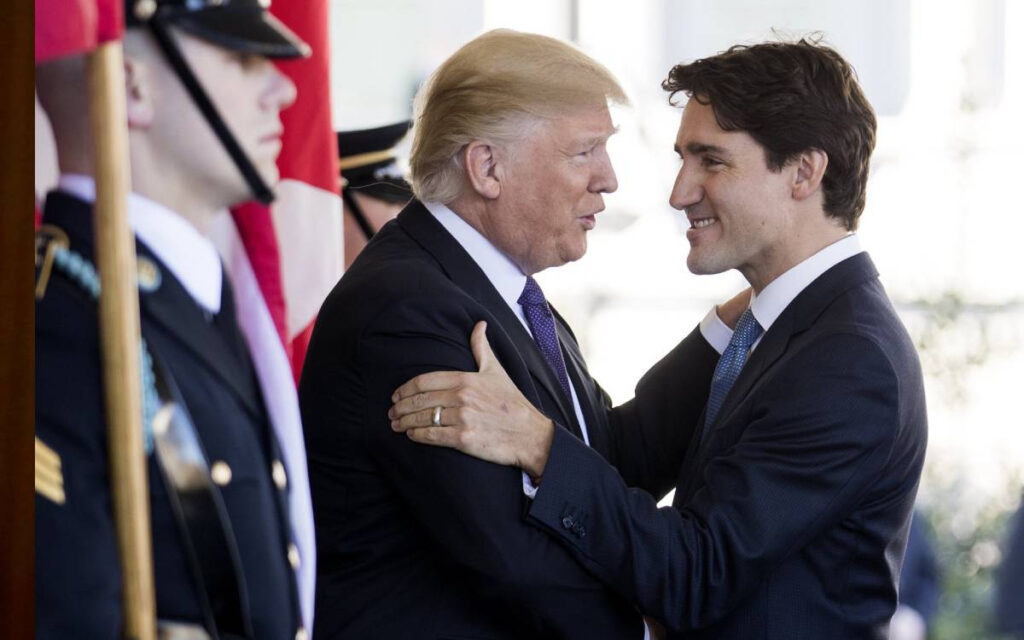
Nothing exposes Canada’s weaknesses quite like a conversation with our closest neighbor and ally. While the reality is that size and geography all but guarantee the U.S. remains in the driver’s seat on critical negotiation, it is incumbent on our political leaders to anticipate the challenges coming down the pipeline. Pictured: Former U.S. president Donald Trump and Prime Minister Justin Trudeau. Photo Credit: EPA/Shawn Thew.
It looks like the 2024 U.S. presidential election is officially set to be a rematch. Not that the Republican primary was much of a contest but with Nikki Haley officially calling it quits this week, former president Donald Trump is left as the lone wolf and heir apparent heading into the home stretch of the nomination process.
That leaves one big question. As the November election date draws nearer, will dis-enchanted voters who parked their vote with President Joe Biden in 2020 make the choice to rally behind him once again?
The polls don’t offer much in the way of certainty for the Biden administration. According to the Wall Street Journal, Trump continues to hold a narrow lead over Biden, albeit still within the margin of error.
It’s not all bad news for Biden, however. His campaign team is likely banking on touting a positive economic outlook by the time voters start tuning in once the summer holidays are out of the way and the current indicators are all trending in his favour. But other factors, like the Biden Administration’s stance on the Gaza-Israel conflict and a volatile immigration situation threaten to rear their ugly head and distract from pocketbook issues.
One thing about the impending election is crystal clear – it doesn’t have the makings of a change election, at least in the traditional sense.
The current president and the former president have been battle tested on the biggest stage in the world, with one term each under their belt. On this front, both candidates are a known commodity to voters.
If Trump proves successful in his presidential bid, uncertainty is the name of the game for political leaders north of the border tasked with managing the policy implications.
The former president has promised to shake up the NATO alliance by hanging countries who don’t meet the defence spending targets out to dry. Since the Russian invasion of Ukraine, several European countries who were laggards on spending have since upped their contributions and a record number of members are now expected to meet the two per cent threshold.
This could have huge implications for Canada. When NAFTA was being renegotiated in the wake of Trump’s election in 2016, Trump wasn’t afraid to slap tariffs on Canadian steel as a bargaining tactic. Not only will defence spending be in his cross hairs due to the geopolitical conflicts happening – Canada will also once again take part in the renegotiations of the North American free trade pact.
When Biden visited Ottawa last year, he spoke of the friendly relationship that existed between the two countries. The reality, however, is that the Biden Administration instituted several protectionist policies that had big implications for Canada, including the cancelling of the Keystone XL pipeline and the implementation of the Buy America plan.
Nothing exposes Canada’s weaknesses quite like a conversation with our closest neighbor and ally. While the reality is that size and geography all but guarantee the U.S. remains in the driver’s seat on critical negotiation, it is incumbent on our political leaders to anticipate the challenges coming down the pipeline. We don’t need the results of the presidential election to know Canada is exposed on several fronts.

Josie Sabatino is a Senior Consultant at Summa Strategies, focused on providing strategic insight and helping clients meet their objectives in an ever changing and complex political and regulatory environment. Prior to joining Summa, Josie spent nearly a decade in political communications and most recently served as the Director of Communications to the Hon. Erin O’Toole, former Leader of the Official Opposition.




















